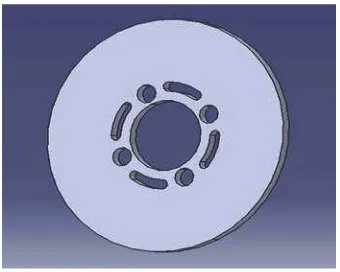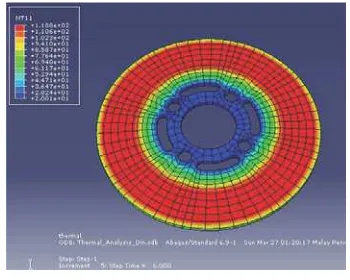3rd
International Conference on Engineering and ICT (ICEI2012) Melaka, Malaysia
4 – 5 April 2012
455
THERMAL ANALYSIS OF A OF BRAKE DISC ROTOR FOR PERSONAL
ELECTRIC VEHICLE
Muhammad Zahir bin Hassan1,a*, Fudhail Abdul Munir1,b, Mohd Rody Mohd Zin1,cand Mohd Irwan Mohd Azmi1,d
1,2Universiti Teknikal Malaysia Melaka/Department of Automotive, Melaka, Malaysia.a
zahir@utem.edu.my, b
fudhail@utem.edu.my,rody@utem.edu.my,mohdirwan@utem.edu.my
Abstract— In this paper, thermal analysis of a brake disc rotor design for a personal electric vehicle(PEV) is demonstrated. The finite element method was used to obtain the temperature behavior during braking and non-braking conditions. Steady state response in temperature distributions was conducted for this research paper. The analysis is limited to heating and cooling condition of the designed brake disc rotor.
Keywordspersonal electric vehicle; thermal analysis of brake disc; finite element method.
I.INTRODUCTION
The first electric vehicle construction is credited to the French inventor and electrical engineer M. Gustave Trouvé, who demonstrated a motorized tricycle powered by lead-acid batteries in 1881 [1].
In 1909, electric cars were operated on lead-acid batteries which managed to exceeded 100 miles per hour in speed at the range of f 180 miles of mileage. The personal electric vehicle (PEV) emerged as a new category of transportation device in the late 1990s [2]. PEVs transport a single passenger over trip distances of 1–10 km and employ electricity as the motive energy source. The category is principally comprised of electric-powered scooters and cycles [3].
PEVs offer several potential benefits to users and to society. The benefits are lower transportation costs, lower trip times and most important of all reduce the environmental impact [4]. PEV is typically open to the weather and operates at very slow speed. The category is principally comprised of electric-powered scooters and cycles.
A better-designed brake disc rotor can help to dissipate heat faster (more efficient) and therefore runs cooler, reduces the chance of heat buildup. For this project, the brake disc rotor is attached to the wheel of personal electric vehicle.
There are two type of disc rotor. The first one is ventilated disc rotor. The ventilated type disc rotor consists of a wider disc with cooling fins cast through the middle or have hole at the surface of the disc rotor to ensure good cooling. Proper cooling prevents fading and ensures longer pad life [5].
Some ventilated rotors have spiral fins which creates more air flow and better cooling [6]. The second type is solid disc rotor or non-ventilated disc rotor. It normally found on the rear of four wheel disc brake systems and on the front of earlier model vehicles.
A thermal analysis calculates the temperature distribution and related thermal quantities in brake disc [7]. During braking, the kinetic energy of the moving
vehicle is converted into thermal energy through friction at the disc and pad interface [8]. Frictional heat is generated at the rubbing surface due to the interactions between the pad and disc. The disc absorbs up to 90% of the generated heat energy by means of conduction away from the friction interface between disc and pad [7]. Typical thermal quantities are:
i. The temperature distribution ii. The amount of heat lost or gained iii. Thermal fluxes
II. DESIGNMETHODOLOGY
There are several properties need to be adhered in designing brake disc rotor. The followings are the properties:
i. Low noise level
ii. Low life cycle cost iii. Low pollution rates iv. Low energy consumption v. Low material consumption vi. Provide safety and reliability vii. High serviceability
A. Design Selection
There are three concepts of disc brake design that can be considered. The designs represent the concept for ventilated and solid disc brake. There are criteria that should be obliged in designing bake disc rotor. The specifications are as follows:
i. Low Cost
ii. Light in weight
iii. Good Cooling properties iv. Safe to be use
B. Concept Design
3rd
International Conference on Engineering and ICT (ICEI2012) Melaka, Malaysia
4 – 5 April 2012
456
Figure 1. Three Dimensional of the Designed Brake Disc
Figure 2 Dimensions of the Disc
Figure 3 Location of the disc in the personal electric vehicle
Material used for the designed disc rotor is gray cast iron grade 220.
C. Defining Parameters
In order to make sure the analysis can be done properly, the heat flux and boundary condition must be calculated. The speed is assumed 25 km/h @ 6.94 m/s and mass of the personal electric vehicle with passenger is 160 kg. Table 1 below shows the calculated values of estimated braking time, stopping distance, kinetic energy, thermal flow and the heat flux.
Table 1.Calculated values of vital parameters
Calculated Parameter Value
Estimated braking time 0.9 s
Braking energy 1270 J
Thermal flow 1412.8 J/s
Heat flux 14.2 kW/s
The heat flux can be defined as heat input on the disc braking surface per unit area.
D. Boundary Conditions
Fig. 4 depicts the boundary condition that must be calculated for this disc brake.
Figure 4 Boundary conditions of the disc brake
The calculated heat flux for the three section is depicted in Table 2 below.
Table 2. Heat Flux for all three sections
Section Heat Flux, W/m2
.K
A 19.1
B 19.1
C 36.2
III. SIMULATIONRESULTSANDDISCUSSION
In this section, result of steady state response in temperature distributions is presented. In the thermal analysis, an initial temperature is applied to the entire
C
3rd
International Conference on Engineering and ICT (ICEI2012) Melaka, Malaysia
4 – 5 April 2012
457
brake disc model. The heat generated by friction with the brake pads is modeled using heat fluxes applied to the surface. The purpose of this study is to obtain a steady-state solution for a brake disc under constant loads with different material due to the pressing of the brake pads against the disc. The result will be representing in term of contours of the temperature distribution and the graph of temperature versus time.
A. Heating Conditions
The temperature distribution of the disc rotor under steady state loading condition and the heat storage effect change over the period of time is ignored. Fig. 5 illustrates the result for initial temperature of simulation and Fig. 6, depicts the result after 6 seconds of running the simulation.
Figure 5Temperature Distribution of Gray Cast Iron (t = 0s)
Figure 6Temperature Distribution of Gray Cast Iron (t = 6s)
The numerical values of the temperature distributions during heating condition is shown in Fig. 7 below.
Figure 7.Graph of temperature distribution for 6s of simulation
As shown in the graph above, the maximum temperature of the brake disc rotor after 6 seconds of load is 118°C.
B. Cooling Conditions
For cooling condition, the heat flux at the braking surface is deactivated which is represents no load is applied. Fig. 8 and 9 below shows the result of cooling condition.
Figure 8Temperature Distribution (cooling) at t=0 s
Figure 9Temperature Distribution (cooling) at t=300 s
IV. CONCLUSIONS
3rd
International Conference on Engineering and ICT (ICEI2012) Melaka, Malaysia
4 – 5 April 2012
458
ACKNOWLEDGMENT
The authors would like to express gratitude to Universiti Teknikal Malaysia Melaka for sponsoring these research activities.
REFERENCES
[1] Wakefield, E. H.,History of the Electric Automobile: Hybrid Electric Vehicles, SAE International, New York, 1998. [2] Abbott, Allan, V., Wilson, Gordon, D. (1995). Human Powered
Vehicles. Human Kinetics, Champaign, Illinois.
[3] Fay, B.T. and Boninger, M.L. (2002). “The science behind mobility devices for individuals with multiple sclerosis”. Medical Engineering & Physics. Vol 24, 375-383.
[4] Roosmalen, L.V., Paquin, J.G. and Steinfield, A.M. (2010). “ Quality of Life Technology: The State of Personal Transportation”. Physical Medicine and Rehabilition Clinics for North America. Vol 21, 111-125.
[5] H.J Cho and C.D. Jo., A Study of Thermal and Mechanical Behaviour for The Optimal Design of Automotive Brake Discs,
Proceeding of IMechE Part D J. Automobile Engineering,222
(2008) 895-915.
[6] H. Jacobson, Aspects of Disc Brake Judder, Proceedings of Institutional Engineers, Part D: J. Automobile Engineering 217(2003) 419-429.
[7] E.Little, T.K. Kao, P. Ferdani, and T. Hodges, A Dynamometer Investigation of Thermal Judder,SAE 982252, 1998. [8] M.Z. Hassan, P.C. Brooks, and D.C. Barton,
Thermo-Mechanical Contact Analysis of Car Disc Brake Squeal,SAE
International Journal of Passenger Cars Mechanical System,

